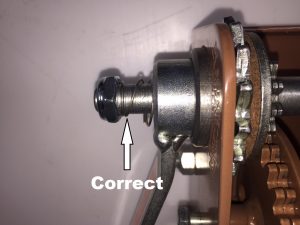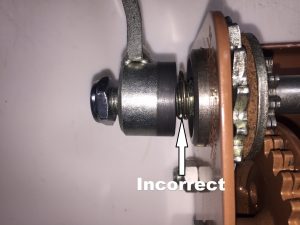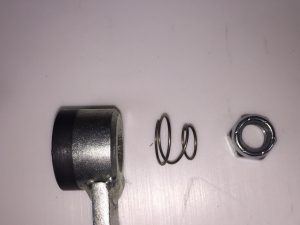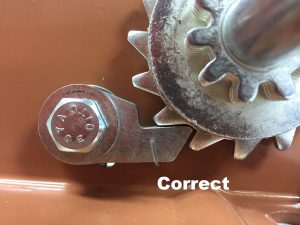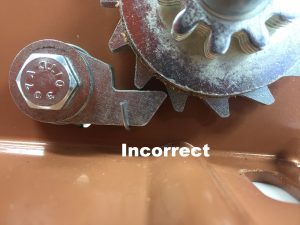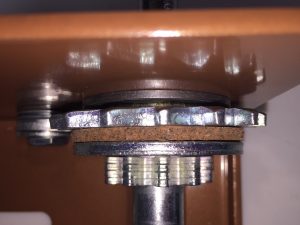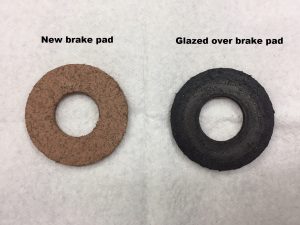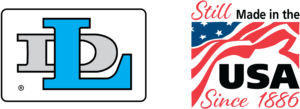Use this manual if you have a DLB350A, DLB350AG, DLB800A, DLB800AG, DLB1200A, DLB1500A, DLB1500AG, DLB2000A, or DLB2500A brake winch.
Find in the list below the problem you are experiencing with your winch, then click the “+” sign near a “Possible Cause” for an explanation of how to fix it.
SAFETY NOTES: All D-L brake winches are built for multipurpose hauling and lifting operations. They are not to be used as hoists for lifting, supporting or transporting people, or for loads over areas where people are present.
Symptoms & Solutions
Winch is brand new. It raises load and makes clicking noise, but when the handle is released, it turns and allows the load to come down.
Corrective Action:
The spring that is intended to go onto the end of the drive shaft may have been placed onto the shaft before the handle was threaded onto the winch. The spring and locknut must be in place on the end of the drive shaft exactly as shown in photo. If spring is not present in this location, it was probably placed on shaft before the handle was installed. This spring and locknut may appear to serve no function, but they provide several important fail-safe features and should not be altered or removed. Remove the locknut from the end of the shaft and remove handle form shaft. If you now find the spring on the shaft it will likely be severely damaged and will need to be replaced. Order spring number 204364. Reassemble parts in the correct order as shown in the photo and the winch should work fine.
Corrective Action:
When the crank handle is turned clockwise the winch should produce a loud sharp clicking noise. If the clicking is very soft, then the ratchet wheel may be assembled backwards. Confirm that the ratchet wheel assembly is on the shaft exactly as shown in the photo. If the wheel is on the shaft backwards, remove the spring and locknut from the end of the shaft and remove the crank handle. The reel will have to be removed from the winch in order to reverse the ratchet wheel on the shaft. after removal of the reel, pop off the retaining ring on the drive shaft and slide the driveshaft towards the small bushing in base, this will disengage the ratchet pawl from wheel. Note that on model DLB2500A the retaining ring on the secondary shaft will also have to be removed and the secondary shaft will need to be slid back out of the way to be able to move the primary shaft. Slide shaft out far enough to be able to remove pressure washer and ratchet wheel from shaft. Reverse direction of the wheel and slide wheel and pressure washer back onto shaft. Using your finger, press ratchet pawl down out of the way and slide drive shaft back into large bushing of the base. Ratchet pawl should now be engaged into ratchet wheel teeth properly. Re-assemble retaining ring back into groove of driveshaft making sure it is pressed all the way into the groove and re-assemble the reel back into the winch.
Winch is older. It used to work perfectly, but now it raises load and makes clicking noise, but when the handle is released, it turns and allows the load to come down.
Corrective Action:
Examine the ratchet pawl and spring, and the bolt and spacer that hold the pawl in place. This maybe somewhat hard to do with the winch assembled, so some disassembly of the winch may be necessary. Examine the tip of the ratchet pawl and the teeth of the ratchet wheel, neither should show any significant wear. The pawl should have significant spring pressure keeping it engaged with the teeth of the ratchet wheel. Confirm that a brake pad is between the washer on the driveshaft and the ratchet wheel and that the pads do not show any obvious damage. If the winch was disassembled for examination, the brake pad should be removed and lightly rubbed with sand paper on both sides to remove any glazing (shiny spots) that may have built-up. If winch was disassembled, reassemble and thread the handle back onto the drive shaft. The pawl should be aligned with the ratchet wheel so that it cannot be forced off to one side of the wheel. Turn the crank handle clockwise and observe the action of the pawl. It should click into each of the ratchet wheel teeth with no binding or hesitation. A broken spring or pawl, a bent ratchet support bolt or the pawl seized onto the ratchet spacer should be obvious if they exist. Obtain and install the necessary repair parts.
Corrective Action:
It may be that the handle hub is seized onto the drive shaft thread by rust or corrosion so that it can not supply enough force on the pressure washer, ratchet, and brake pads and ratchet wheel to lock the winch. After removing the load from the winch, the handle (or wheel) should be able to be turned very easily on the drive shaft thread. This is designed to be a loose fitting thread. If there is any resistance to free movement, disassemble the spring and locknut on the end of the shaft so that the handle can be removed and then investigate the cause of the tightness. Note that if your winch uses a wheel in place of the standard crank handle, the threaded hub of the wheel is often not manufactured by Dutton-Lainson Company and may have been manufactured to tighter dimensions so that the threads do not move as freely as they should. Wheels are also sometimes manufactured with aluminum hubs instead of the steel hubs used on the standard handles. The aluminum threads can be more easily damaged and can be the reason the threads are not moving freely. After insuring that the handle hub threads move freely on the drive shaft thread, apply a small amount of grease on the thread and reassemble the winch.
Corrective Action:
Some manufacturers of crank wheels use a hub that does not have a counter bore in the side that contacts the pressure washer on the driveshaft. This makes it possible that the hub is not contacting the pressure washer because it has stopped at the end of the thread on the drive shaft preventing the hub from properly tightening against the pressure washer. If you find this to be the case, replace the wheel with a standard crank handle (number 5703509) until you can obtain a wheel with a properly machined hub from the manufacturer of your lift.
Winch raises load, but does not make clicking noise, and when handle is released, it turns and allows the load to come down.
Corrective Action:
When the crank handle is turned clockwise the winch should produce a loud sharp clicking noise. If this clicking noise can not be heard, then investigate the following possible causes. Examine the ratchet pawl and spring, and the bolt and spacer that hold the pawl in place. Removal of the reel will be necessary to make this examination. Examine the tip of the ratchet pawl and the teeth of the ratchet wheel, neither should show any significant wear. The pawl should have significant spring pressure keeping it engaged with the teeth of the ratchet wheel. Confirm that the brake pad is between the washer on the driveshaft and the ratchet wheel and that it does not show any obvious damage. If the brake pad is missing or shows signs of damage, pop off the retaining ring on the driveshaft and slide the driveshaft towards the small bushing in the base, this will dis-engage the ratchet pawl from the wheel. Note that on model DLB2500A the retaining ring in the secondary shaft will also have to be removed and this shaft will need to be back out of the way to be able to move the primary shaft. Slide out far enough to be able to remove pressure washer and ratchet wheel from shaft and replace brake pad. If brake pad is not damaged and shows only signs of light wear, remove it and lightly rub it with sandpaper on both sides to remove any glazing (shiny spots) that has built up. Reassemble brake pad, ratchet wheel, and pressure washer back onto the driveshaft. Make certain that the teeth on the ratchet wheel are oriented as shown in the photo. Using your finger, press ratchet pawl down out of the way and slide driveshaft back into large bushing on the base. Ratchet pawl should now be engaged into ratchet wheel teeth properly. Reassemble retaining ring back into groove of the driveshaft making sure it is pressed all the way into the groove and reassemble the reel back into the winch.
Corrective Action:
It is not unusual for boat lift manufacturers to alter the components that secure the handle or crank wheel onto the winch drive shaft. This is especially true if the crank wheel hub is made longer than the hub used on the standard crank handle. This often creates the potential for the handle or wheel to get jammed onto the shaft so that the brake is not engaged. Examine the photo showing the standard assembly of components on the end of the shaft. If the spring is not present, the potential for a jam exists. When the handle (or wheel) is turned clockwise, space must be present between the outer face of the hub and the end of the locknut on the driveshaft. If space is not present here, the parts could be jammed preventing engagement of the brake. Loosen the locknut on the end of the shaft and then turn the handle clockwise to engage the brake. Then re-tighten the locknut making sure that space remains between the face of the hub and the retaining washer.
Corrective Action:
Some manufacturers of crank wheels use a hub that does not have a counter bore in the side that contacts the brake pad of the winch. This makes it possible that the hub has come to the end of the thread on the driveshaft preventing contacting the shoulder of the drive shaft preventing the hub from tightening against the brake pressure washer that locks the brake mechanism in the winch. This might also be caused by a broken or crushed brake pad. If you find a broken or crushed brake pad, replacing the pads (number 204362) should solve the problem. It would also be desirable to obtain a new crank wheel with a properly machined hub from the manufacturer of your lift. A counter bore in the face of the hub will allow the hub to contact the brake parts even if one of the pads gets broken.
Corrective Action:
It is not unusual for boat lift manufacturers to alter the components that secure the handle or crank wheel onto the winch drive shaft. This is especially true if the crank wheel hub is made longer than the hub used on the standard crank handle. This often creates the potential for a load to be raised by turning the handle in the counterclockwise direction. Doing this does not engage the brake mechanism and the winch will not hold the load in place. The handle must be turned in the clockwise direction to raise a load. Examine the photo showing the standard assembly of components on the end of the shaft. If the spring is not present, the potential exists for raising a load in the wrong direction. If this has occurred, wind all of the line off of the winch by cranking clockwise. Loosen the nut on the end of the shaft and continue to turn the handle clockwise to engage the brake. You should begin to hear a clicking noise from the brake. Retighten the nut making sure that space remains between the face of the hub and the nut. Space must be present between the outer face of the hub and the nut on the shaft in order for the winch to work properly.
Winch raises load with normal effort, but is harder to crank when lowering load.
Corrective Action:
Remove crank handle from winch and apply a small amount of grease to drive shaft thread. Handle needs to thread on and off driveshaft freely for the winch to work properly.
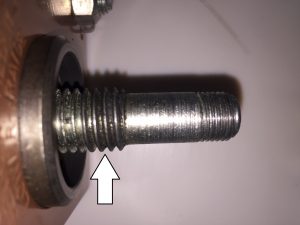
Winch is very difficult to crank while raising and lowering a load.
Corrective Action:
Examine winch frame for any bend or distortion that could cause binding of drive shaft(s) and bearings. The winch needs to be mounted with three bolts. Unfortunately, if the frame of the winch is bent, it generally can not be easily repaired and the winch must be replaced.
Corrective Action:
Remove any load from the winch. In this condition the gears, drive shaft(s) and reel should all have a little bit of looseness. Then check each of the major components to see if it is able to be moved with your fingers. Drive shafts and the reel should be able to move slightly back and forth and side to side. If any of the components can not be moved, investigate further to find and correct the source of the bind. When moving the reel, make sure that the long bolt through the center of the reel remains stationary. If the reel bolt moves with the reel, then the bolt is probably seized in the reel hub. Disassemble, which may require driving the bolt out with hammer and punch, and determine the extent of damage. Also examine the reel bolt holes in the winch frame for any damage. If the holes are noticeably elongated from the bolt turning in the frame, the best course of action will be to replace the winch.
Corrective Action:
Confirm the load on the winch is within the capacity of the winch, refer to owners manual.
Winch raises and holds a load with no difficulty, but when attempting to lower the load the handle unthreads off the shaft and the load does not come down.
Corrective Action:
These winches require a minimum load for the load to move freely during the lowering process. The minimum operating load requirement is 50lbs for models DLB350A, DLB800A, and DLB1200A, 75lbs for models DLB1500A, and 175lbs for model DLB2500A. The winch may still work with somewhat less than this amount of load, but lowering process may tend to be a bit jerky.
Corrective Action:
Cable may have become wedged between the wraps of lower layers. If load being raised is heavier than the load being lowered, cable may become wedged into lower wraps in raising the load; however, with less weight in the lowering process there may not be enough weight to un-wedge the cable. Adding extra weight in the lowering process may be necessary to un-wedge cable. Avoid this problem by keeping cable neatly and tightly wound on drum.
Corrective Action:
Be sure winch is not overloaded, check owners manual for load rating of the winch. Overloading can cause the frame to flex and bend; which will bind gears as well as other parts. If gear teeth on the driveshaft’s and reel are worn or broken, these parts need to be replaced.
Corrective Action:
Examine winch frame for any bend or distortion that could cause binding of driveshaft(s) and bearings. Winch should be mounted with three bolts, washers, and lock washers. Unfortunately, if the frame is bent, it generally cannot be easily repaired and the winch must be replaced.
Corrective Action:
Ensure that your winch’s reel bolt is not overtightened, as this could prevent the reel from turning and your load coming down. There should be a small gap between the reel hub and the base of the winch, as show in the below picture.
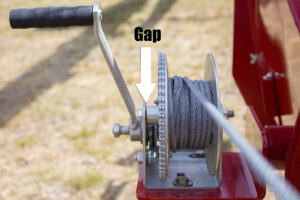
Winch will not raise load.
Corrective Action:
1. Gears could be jammed, examine all gear teeth for any obstruction that could be causing the bind.
2. Driveshaft(s) bent causing gears to jam together, replace driveshaft(s).
Corrective Action:
1. Examine the reel bolt holes in the winch frame for any damage. If the holes are noticeably elongated from the bolt turning in the frame, reel gears may have come dis-engaged from mating gears. This would have been caused by the reel bolt seizing in the reel. Reel bolt requires periodical greasing to prevent this from occurring. The best course of action will be to replace the winch.
2. One or more gear teeth have broken off one of the driveshaft’s. Check entire gear train for any broken teeth. Although rare, its possible that gear attachment to driveshaft has failed on primary (or secondary) driveshaft’s, this would allow the handle to be turned; however, the winch will not raise or lower a load. Replace driveshaft.
Corrective Action:
Check that cable attachment to the reel is secure. Refer to owner’s manual for proper attachment of cable to reel.

